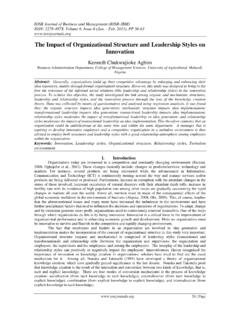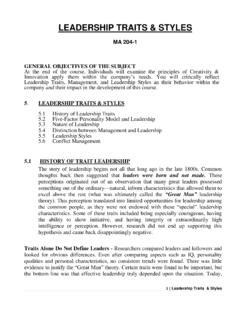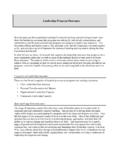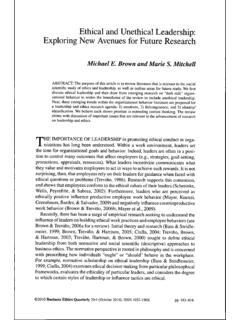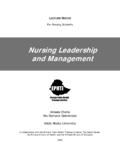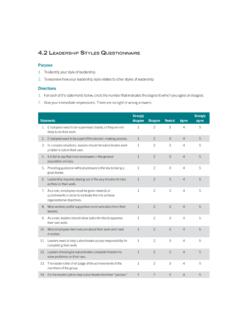Transcription of Distributed Leadership in Educational Institutions
1 Journal of Education and Training Studies Vol. 3, No. 4; July 2015 ISSN 2324-805X E-ISSN 2324-8068 Published by Redfame Publishing URL: 110 Distributed Leadership in Educational Institutions S leyman G ksoy Correspondence: S leyman G ksoy, Faculty of Education, Educational Sciences, Educational Administration and Supervision, University of D zce, 81620, D zce, Turkey Received: May 4, 2015 Accepted: May 21, 2015 Online Published: June 2, 2015 URL.
2 Abstract In recent years, many studies are conducted about shared Leadership process. Distributed Leadership (DL) approach addresses Leadership along with teams, groups and organizational characteristics. In practice, this approach objects the supposition that an individual should take the lead in order to ensure change. Proponents of this idea claim that shared Leadership is required since Educational Institutions are too complex to be managed with only one individual.
3 Responsibility for managing various complex tasks in organizations is Distributed among a myriad of individuals with different roles. The basic principle advocated in this approach is based on the futility of efforts to ascertain a series of best single leader characteristics or best single leader behaviors. Current study aims to provide information on Distributed Leadership and discuss the applicability of the concept in Educational organizations. Keywords: Educational organizations, Leadership , Distributed Leadership 1.
4 Introduction Although investigations on Leadership concept date back to Plato s The Republic written in 400 and thousands of studies, books and movies exist on the topic due to its importance which are designed to relate what is Leadership and how to be a good leader, there are still areas that are uncovered about the concept (Lunenburg & Ornstein, 2013). In definitions of traditional Leadership , Leadership is defined as the process of influencing a group to reach goals (Robbins, 1994).
5 That is to say, when observers are affected by a single individual in the realization of aims, it is claimed that Leadership process is in effect (Birdal & Aydemir, 1992) in this situation. Therefore, the essence of traditional Leadership process consists of one individual s effect on others (Ko el, 1999). Leader in this Leadership process is accepted as the person with the most or highest effect on the members of the group and defined as the individual with the highest impact on individuals or groups (Freadman, Sears & Carlsmith, 2003:539) and as the individual who leads others to act in a specific way for a specific purpose (Hitt et.)
6 Al., 1975; Ert rk, 2000). Recent Distributed Leadership approach can be said to fully change even ignore the traditional Leadership and leader definitions since Leadership in Distributed Leadership approach has a more complex structure than Leadership behaviors (Harris & Lambert ,2003; Leithwood, Day et. al, 2006). Leadership structure and effective Leadership practices are combined in four categories: identification of targets, development of individuals, reconstituting the organizational structure and improving teaching and Educational program (Malloy, 2012).
7 Distributed Leadership is a result of reflecting the cognizance on organizational management regarding the view that Leadership roles and positions should be shared. That is to say, Distributed Leadership addresses the entirety of human resources in organizations, especially the academic staff in Educational organizations as leaders. According to this Leadership model, it is fundamental to develop Leadership potentials of human resources at schools and provide equal chances and statuses for the staff to realize the goals of the school.
8 The basic philosophy underlining this approach is the mobilization of shared wisdom and common sense by creating synergy among the staff at organizations and maximization of organizational efficiency, productivity and competence which will ensure achievement and happiness in the members of the organization. Distributed Leadership model regards the management and operations of organizations in general and school organizations in particular as complex and complicated processes.
9 Therefore, school management, which is a complicated and hard task, cannot be left to a single leader or Leadership approach or potential because school structures are not easy to be managed effectively with the Leadership of a single person. Developmental Process of Leadership Approaches Starting with the second half of the 20th century, scientific studies on Leadership have focused on the characteristics that Journal of Education and Training Studies Vol.
10 3, No. 4; 2015 111 separate leaders from non-leaders and leaders from their followers (Hoy & Miskel,2012) and effective leaders from ineffective leaders. Trait theory, the first of Leadership theories, proposes the behaviors that separate leaders from non-leaders (Robbins & Judge, 2012). Studies have presented many personal characteristics of leaders (Bass, 1990). In fact, the main element that highlights a single person as the leader is the personal characteristics.











